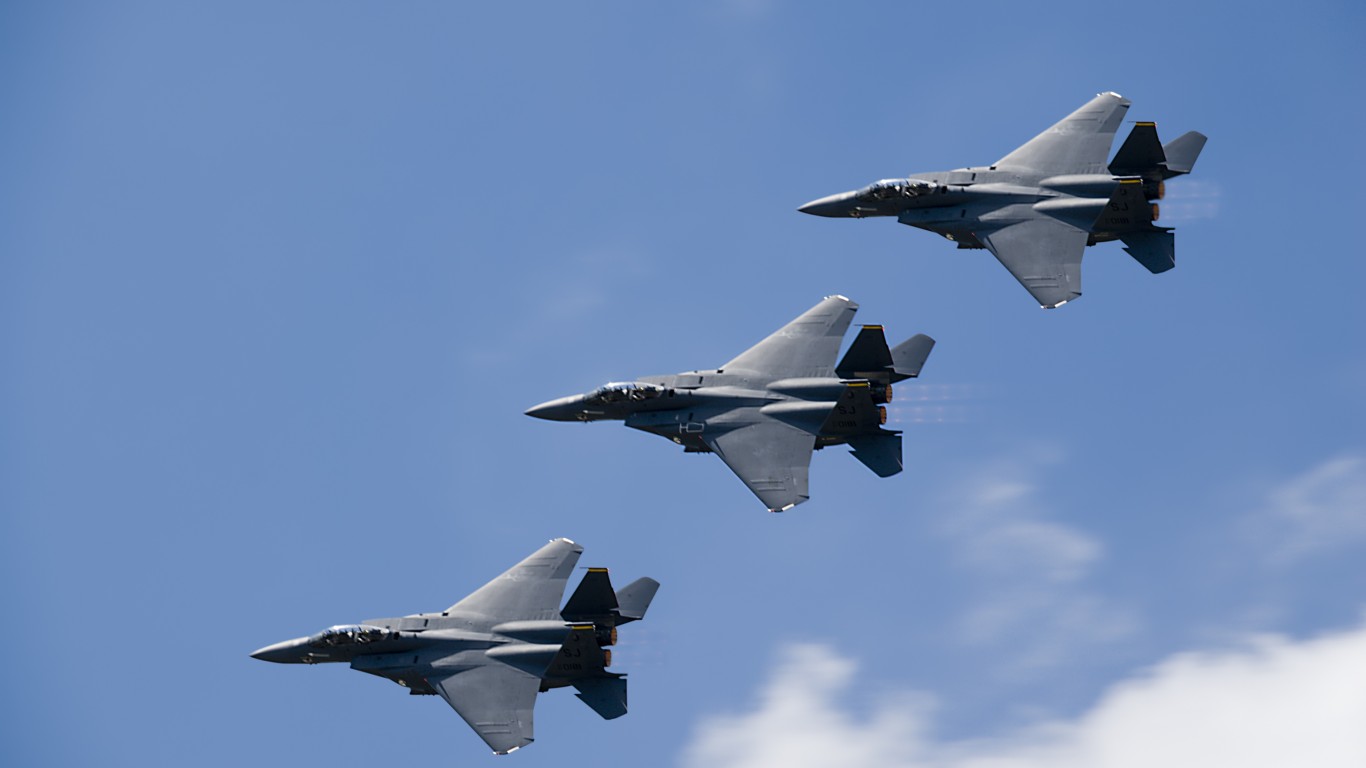
The first operational fighter jet was the German Messerschmitt’s Me 262, used in July 1944 to attack the Mosquito, a British photo-reconnaissance plane. The United States followed not long after with its first fighter jet, the P-80 Shooting Star, used toward the end of the Second World War. Since their emergence post-World War II, fighter jets have played a pivotal role in military operations and national defense strategies.
In the years since there have been a multitude of fighter jets developed and a select few continue to hold a prominent place, with some still in active service worldwide even after half a century. Hailed as the next-gen fighter jet, the F-35 Lightning II, first flown in late 2006, is currently in rapid production. As Russia’s war in Ukraine persists, NATO members are acquiring these aircraft to bolster their air forces. (See, these are the largest air forces in the world.)
To determine the most widely-used fighter jets in the world, 24/7 Wall St. referenced the report, 2023 World Air Forces, from FlightGlobal, an aviation and aerospace industry website. Aircraft were ranked here by the number of units in active service across the world’s militaries. Supplemental data regarding manufacturer, first flight, notable variants, and initial use came from Military Factory, an online database of military vehicles, aircraft, arms, and more.
The F-16 Fighting Falcon tops this list as the most widely used fighter jet in the world. Originally developed by General Dynamics and now produced by Lockheed Martin, it has been the backbone of many air forces worldwide since its introduction in 1978. Renowned for its maneuverability, high speed, and lightweight construction, the F-16 can perform various operational roles. These features have allowed the F-16 to become NATO’s primary fleet aircraft and serve in over 25 air forces.
The then-Soviet Union introduced the Su-27 Flanker in 1985, a fighter jet that was developed by Sukhoi to counter the United States F-15 Eagle. Like many other modern fighter jets, the Su-27 plays several operational roles, and it has been in service in more than 10 other air forces, including China, Vietnam, Ukraine, and Russia. Apart from its exceptional dogfighting capabilities, the Su-27 was later upgraded to include ground attack and electronic warfare capabilities. More than 1,100 Su-27s are presently operational worldwide. (Also see, every plane in Russia’s air force.)
Most of the aircraft on this list come from the United States and Russia, or the former Soviet Union. A majority of the aircraft developed by these two countries were produced during the Cold War and were part of the military buildup on both sides. When the Cold War came to an end, however, there was a surplus of military supplies, including aircraft, that were sold to respective allies of the United States and Russia, which explains the proliferation of these arms across the globe.
The fighter jets that comprise this list have proven their effectiveness in conflicts around the world. These jets have earned an iconic status within many militaries for their lethality, speed, and firepower.
Here are the most widely used fighter jets in the world
10. F-5 Freedom Fighter
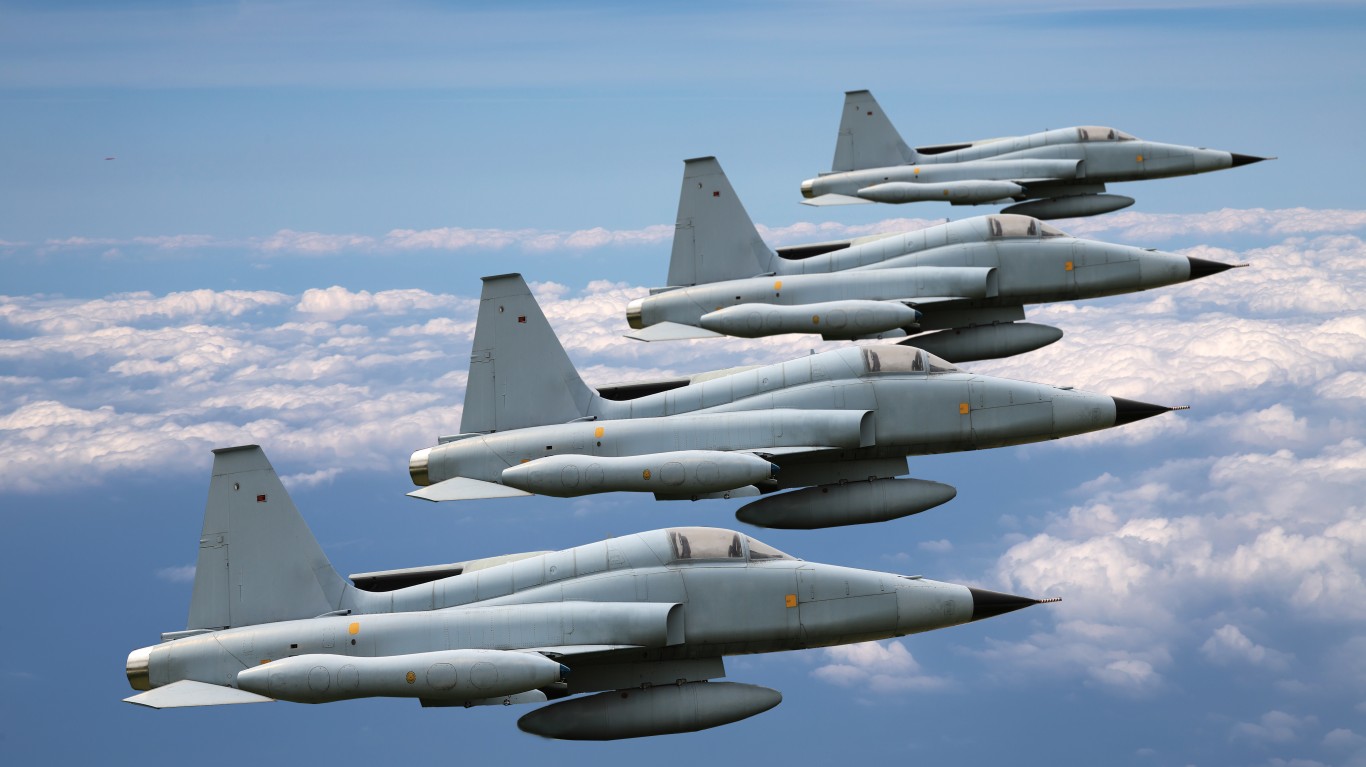
- Number of jets in service as of 2023: 403
- Manufactured by: Northrop Grumman
- First flight: 1963
- Initially used by: United States
- Notable variants: F-5E Tiger II
Ever since its introduction in 1963, the F-5, built by Northrop Grumman, has proved to be a reliable, economical, and very maneuverable jet fighter. Northrop Grumman built more than 2,600 of them until it ceased production in 1989. About two-thirds of the original production aircraft operate in 26 countries, including the United States.
The jet fighter has evolved from a frontline fighting machine to a training aircraft, extending its usage life.
9. J-7 Fishcan
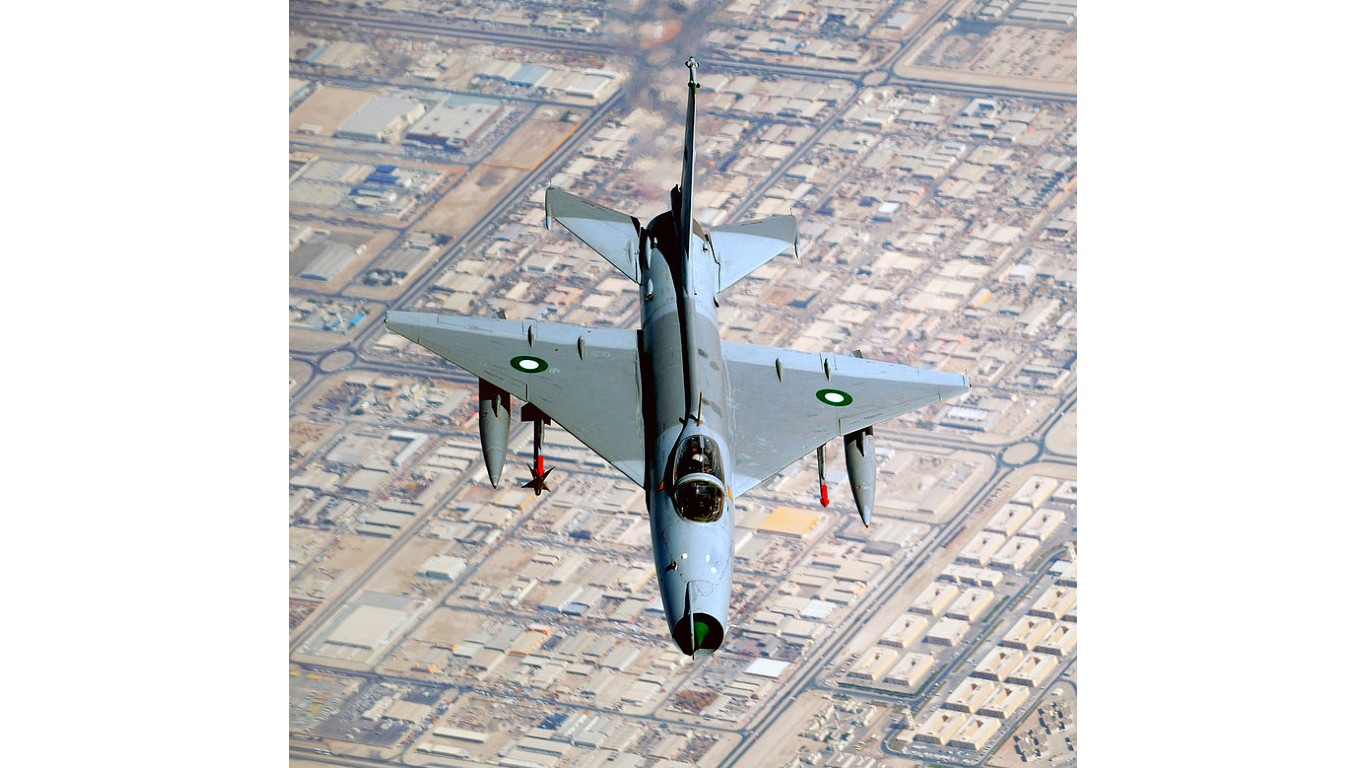
- Number of jets in service as of 2023: 444
- Manufactured by: Aviation Industry Corporation of China, Chengdu
- First flight: 1966
- Initially used by: China
- Notable variants: J-7 I/II/III
China’s J-7 is a single-engine, lightweight fighter aircraft designed and made by Chengdu Aircraft Corp. of China. Its design is based on its predecessor, the renowned Soviet-made MiG-21 aircraft. From 1996 to 2013, more than 2,400 J-7s were built, according to Airforce Technology.
Chengdu Aircraft built two types of J-7 variants – a domestic Chinese version and an export variant. About 26 export variants are in operation worldwide, including in the air forces of Namibia, Nigeria, Bangladesh, and Pakistan.
8. Su-25 Grach Frogfoot
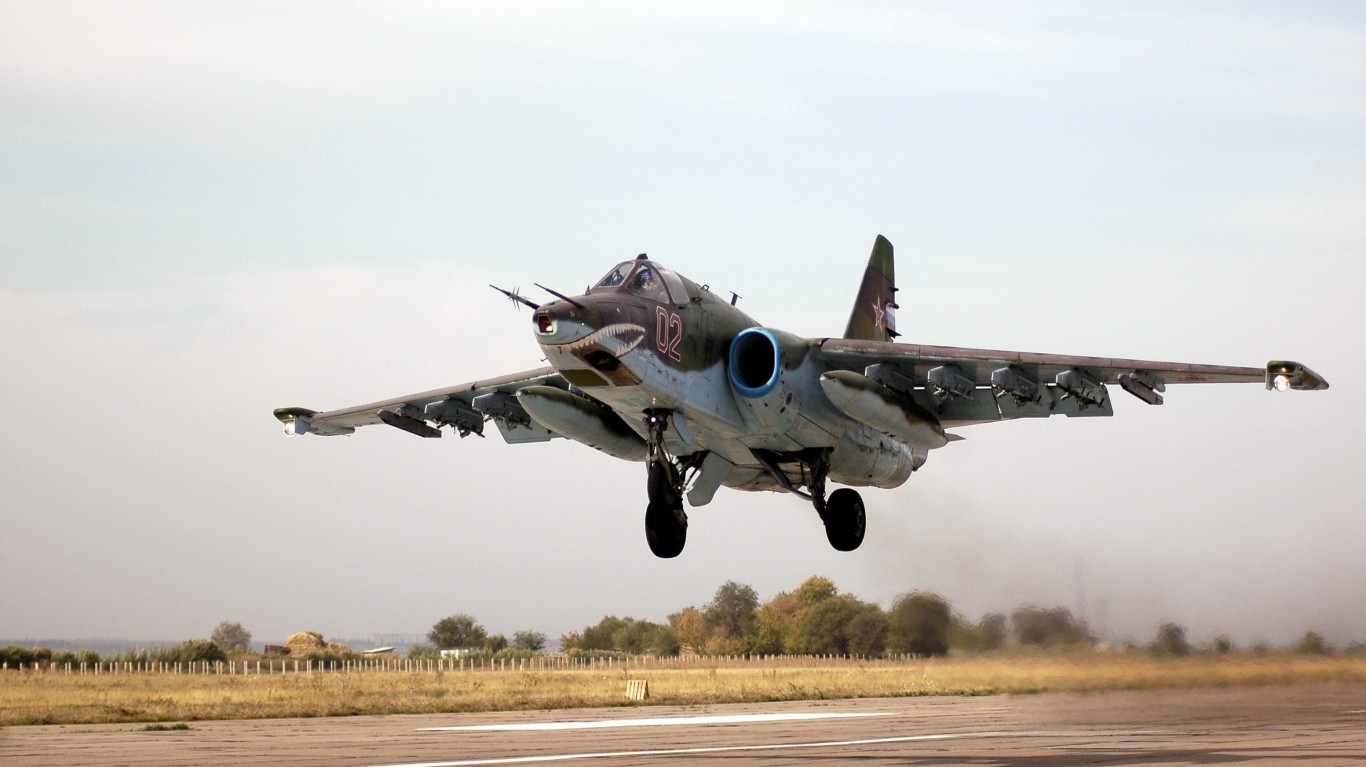
- Number of jets in service as of 2023: 480
- Manufactured by: Sukhoi OKB
- First flight: 1972
- Initially used by: Soviet Union
- Notable variants: Su-25 Frogfoot-A, Su-25KM Scorpion
The Su-25, from the Soviet Union, has been involved in many conflicts since it was first built in the early 1970s. The Sukhoi Su-25 is a single-seat, twin-engine jet aircraft designed to provide close air support for ground forces. It is believed that its distinctive nose-mounted laser rangefinder is employed to provide laser-based targeting.
The aircraft flew in the Soviet war in Afghanistan, and a variant commissioned by the Iraqi air forces performed about 900 combat sorties in its war against Iran. Many of the Iraqi Su-25s were destroyed on the ground by coalition forces during the Gulf War in 1991. Following the collapse of the Soviet Union, Russia utilized the Su-25 in both Chechen wars in the 1990s and the conflict with Georgia in 2008, in which Georgia flew its own Su-25s.
The Russian Air Force operates the largest number of Su-25s and had planned to upgrade older aircraft, but funding shortfalls have slowed the progress.
7. Eurofighter Typhoon

- Number of jets in service as of 2023: 522
- Manufactured by: BAe Systems, EADS, Alenia
- First flight: 1986
- Initially used by: Germany
- Notable variants: Typhoon F1, Typhoon T1
Eurofighter Typhoon was the most expensive combat aircraft built in Europe, developed by a consortium of British, German, Italian, and Spanish aerospace companies. Funding, technical, and design disputes among the nations involved held up production initially, but it has seen a significant production run since then. The manufacturers touted it as the world’s most advanced fighter aircraft.
The multi-role aircraft was designed for ground attack and air defense. Its features include a target display on the pilot’s visor, a voice-activated computer system, and radar. Austria and Saudi Arabia each purchased the aircraft.
6. F-35 Lightning II

- Number of jets in service as of 2023: 545
- Manufactured by: Lockheed Martin, Northrop Grumman, BAe Systems
- First flight: 2006
- Initially used by: United States
- Notable variants: F-35 Lightning II A/B/C
F-35 Lightning II manufacturer Lockheed Martin touts the jet fighter as “the centerpiece of 21st-century global security.” The fifth generation of aircraft features very low observable stealth technology, advanced sensors, information fusion that creates a single integrated picture of the battlefield, and network connectivity.
Besides its long range and maneuverability, the F-35 Lightning II is known for its ability to collect, analyze, and share data. The U.S. and 14 international allies fly the F-35.
5. Mikoyan MiG-29
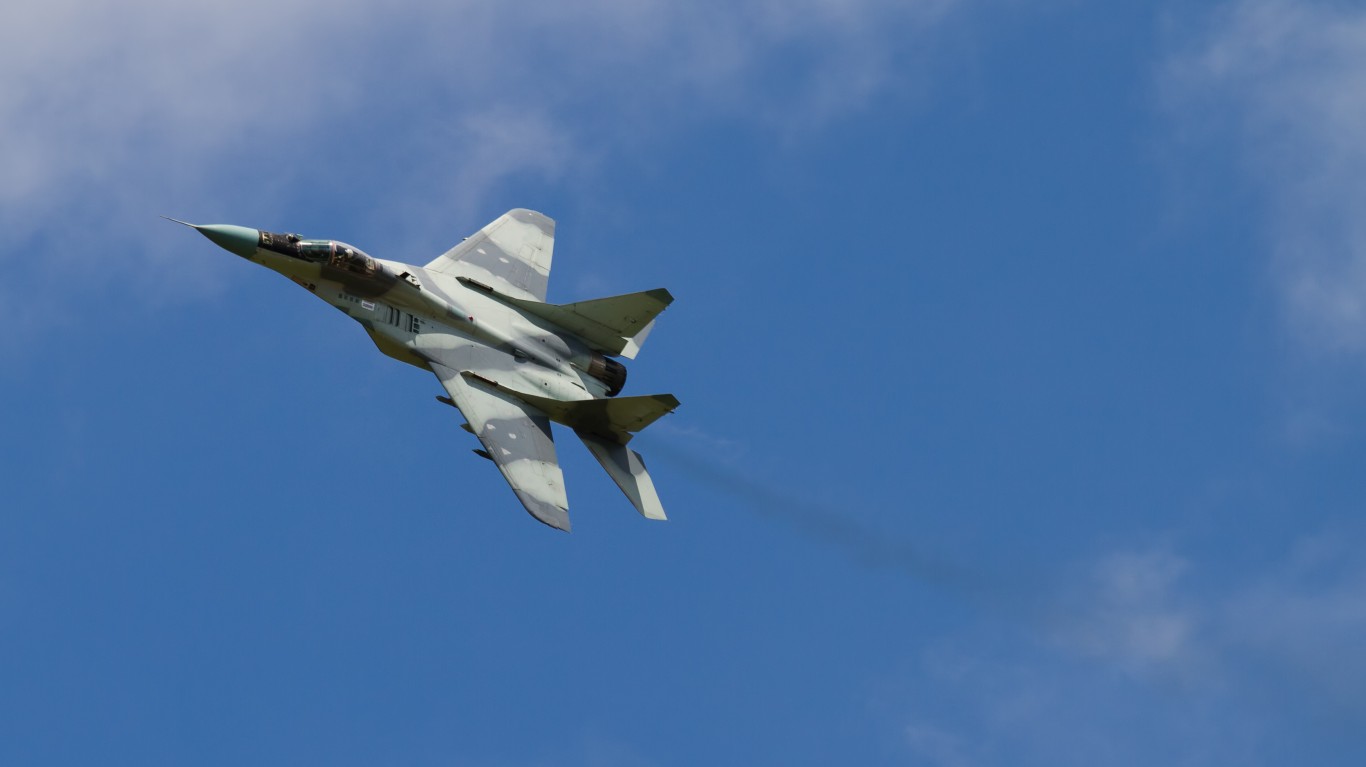
- Number of jets in service as of 2023: 822
- Manufactured by: United Aircraft Corporation, Mikoyan OKB
- First flight: 1977
- Initially used by: Soviet Union
- Notable variants: MiG-29 Fulcrum A/B/C/D/E/F
The MiG-29 jet fighter was the Soviet Union’s answer to the American-made F-15 and F-16. It entered service for the Soviet Air Force in 1982 and was intended to oppose enemy aircraft. Its role changed to that of a multirole fighter.
MiG-29s are sometimes equipped to use a range of air-to-surface armaments and precision munitions. Their swept-back wing design provides great maneuverability. After the Soviet Union dissolved, the MiG-29 continued to be used by the former Soviet republics, including Russia’s air force. More than 30 other countries have operated the aircraft.
4. F/A-18 Hornet
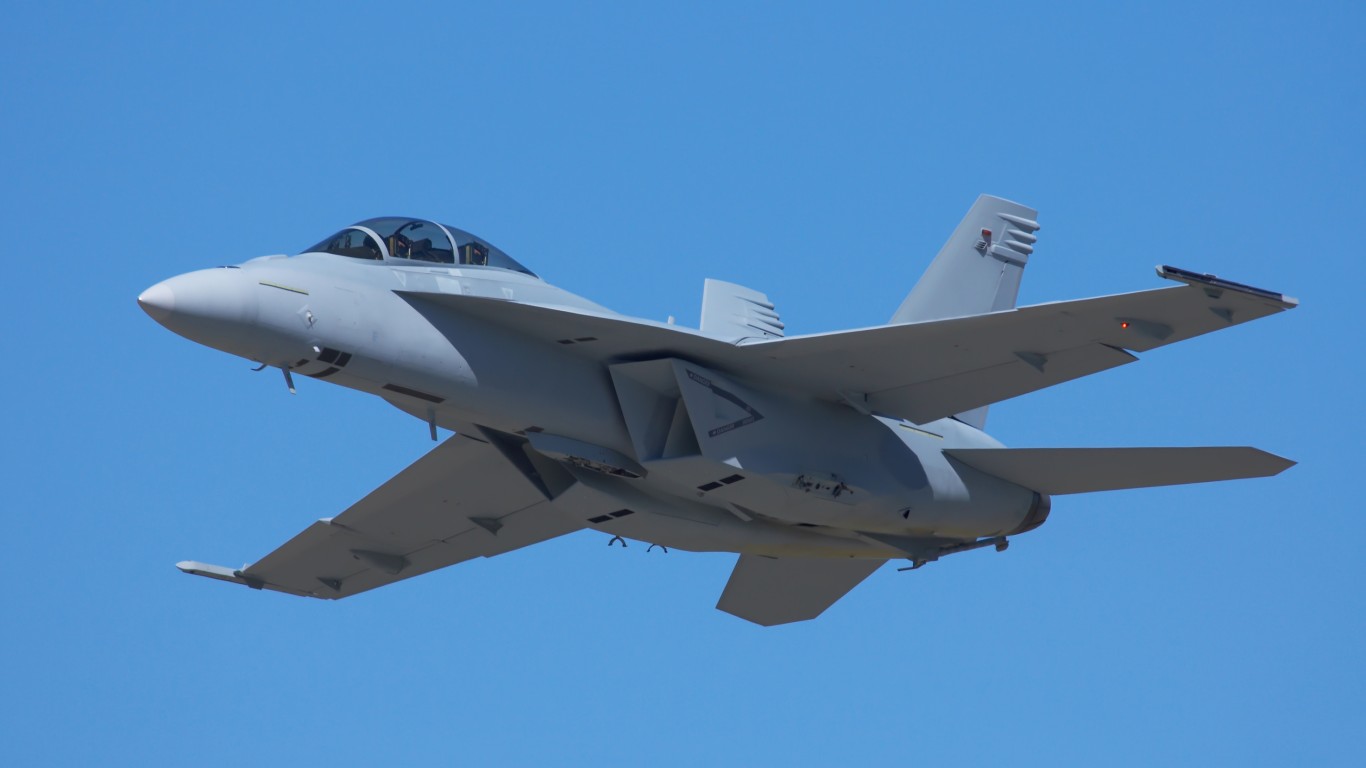
- Number of jets in service as of 2023: 828
- Manufactured by: Boeing, Northrop Grumman, McDonnell Douglas
- First flight: 1978
- Initially used by: United States
- Notable variants: F/A-18E Super Hornet, Growler
F/A-18 Hornet, flown by the U.S. Navy and U.S. Marines, is America’s first all-weather twin-engine fighter and attack aircraft. The F/A-18 entered operational service with the Marine Corps in 1983 and the U.S. Navy a year later. It proved its worth in Operation Desert Storm, the second phase of the Gulf War in 1991, by shooting down enemy aircraft and bombing targets during the same mission. The Hornet also demonstrated its survivability from direct hits from surface to missiles by taking only one day for repairs and returning directly to service.
The U.S. Navy’s Blu Angels perform flight demonstrations with the F/A-18 Hornet. The jet fighter has been part of the aviation strike forces of Canada, Australia, Finland, and Malaysia, among other countries.
3. F-15 Eagle
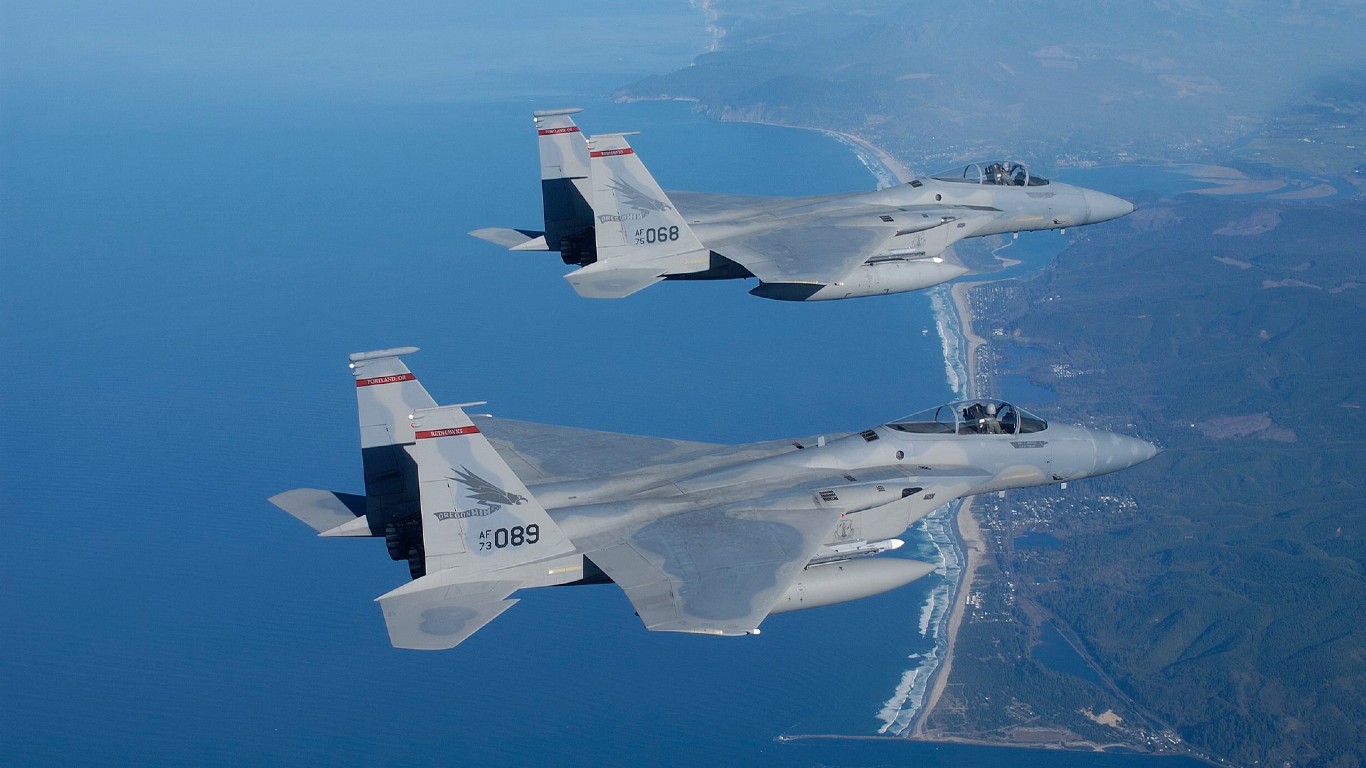
- Number of jets in service as of 2023: 961
- Manufactured by: Boeing, McDonnell Douglas
- First flight: 1976
- Initially used by: United States
- Notable variants: F-15E Strike Eagle, F-15K Slam Eagle, F-15I Ra’am
The F-15E Strike Eagle is a dual-role fighter designed to perform air-to-air and air-to-ground missions. It was first put into service for the U.S. Air Force in the mid-1970s. The F-15 Eagle is known for its maneuverability and superior acceleration.
It was the first U.S. aircraft whose engines’ thrust exceeded the plane’s loaded weight. This allowed it to accelerate even while it was climbing. Its high thrust-to-weight ratio also enables it to turn without losing airspeed. The F-15 Eagle’s targeting pod features a laser designator and tracking system that can mark an enemy at great distances.
2. Sukhoi Su-27/30/34/35
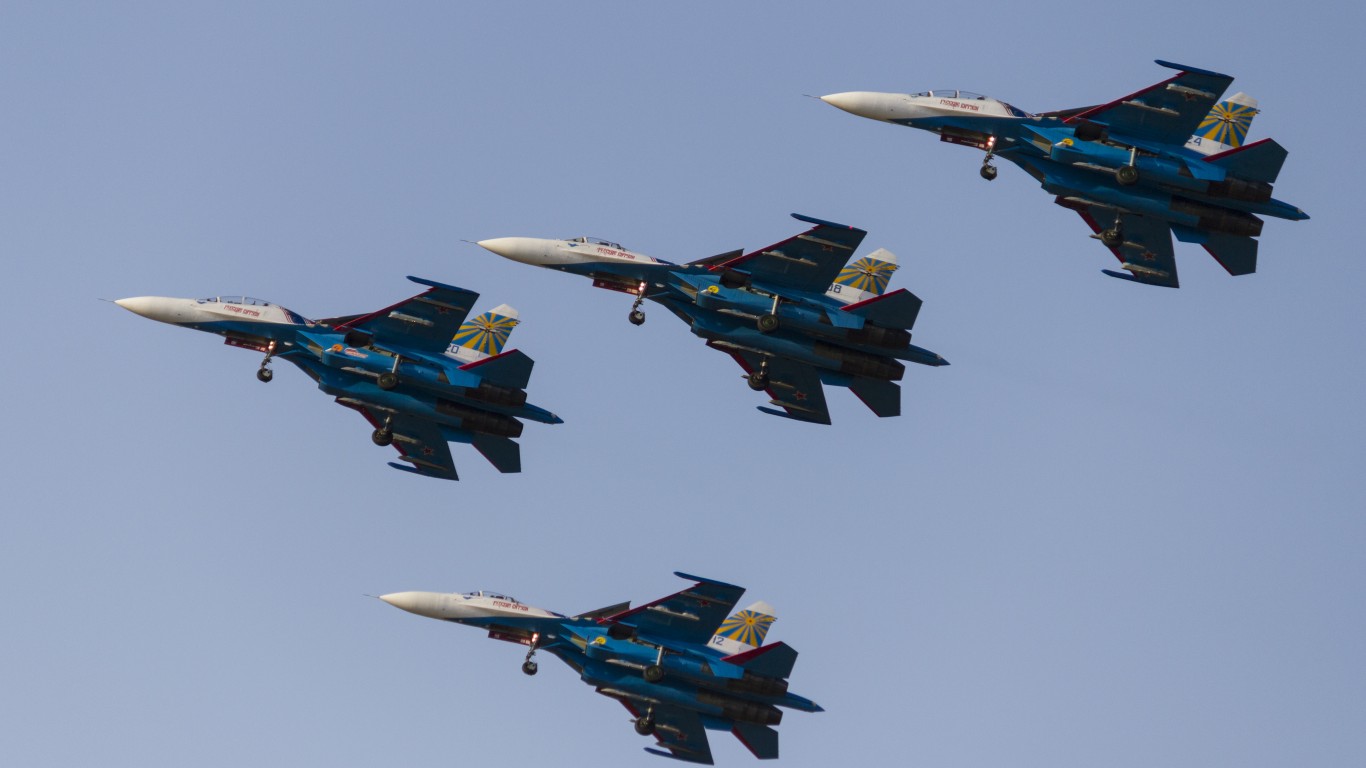
- Number of jets in service as of 2023: 1,187
- Manufactured by: United Aircraft Corporation, Sukhoi OKB
- First flight: 1985
- Initially used by: Soviet Union
- Notable variants: Su-27 Flanker, Su-34 Fullback
The Soviet Union wanted to develop a jet fighter that could challenge the American F-15. After some technical problems that reportedly cost the lives of several Soviet pilots, the Su-27 was redesigned and eventually put into service in 1985.
Its variants are still widely used, including those flown in China, and it has lived up to its reputation as a capable and reliable jet fighter. The Su-27 has formidable armament with up to 10 air-to-air missiles. It is very maneuverable, and its robust fuel capacity allows it to work as an escort fighter.
1. F-16 Fighting Falcon
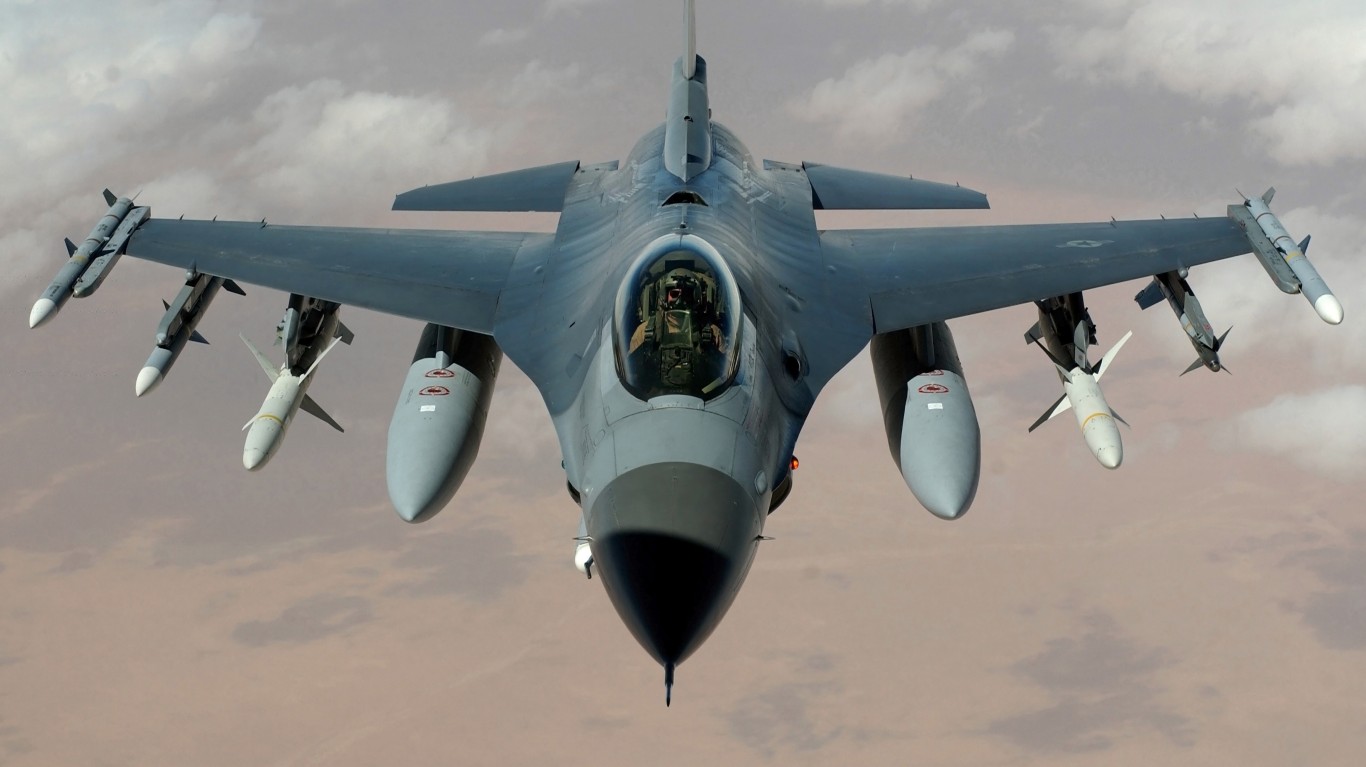
- Number of jets in service as of 2023: 2,184
- Manufactured by: Lockheed Martin, General Dynamics
- First flight: 1978
- Initially used by: United States
- Notable variants: F-16 A/B/C/D/E
A group of NATO countries and the U.S. took part in manufacturing the F-16, which the Air Force named the Fighting Falcon. The multirole aircraft is a low-cost, highly maneuverable jet with a lightweight fuselage. It has proven its mettle in combat. The F-16 can withstand up to nine times the force of gravity, exceeding the capability of other fighter aircraft.
F-16 multirole fighters were deployed to the Gulf War in 1991 in support of Operation Desert Storm, where more sorties were flown with it than with any other aircraft. They attacked airfields, military production facilities, and Scud missile sites, and they destroyed MiG fighters on the ground, tanks, and radar installations.
There are more than 2,100 F-16 Fighting Falcons still in use, nearly more than twice the number of the next-highest jet fighters on the list.
Get Ready To Retire (Sponsored)
Start by taking a quick retirement quiz from SmartAsset that will match you with up to 3 financial advisors that serve your area and beyond in 5 minutes, or less.
Each advisor has been vetted by SmartAsset and is held to a fiduciary standard to act in your best interests.
Here’s how it works:
1. Answer SmartAsset advisor match quiz
2. Review your pre-screened matches at your leisure. Check out the advisors’ profiles.
3. Speak with advisors at no cost to you. Have an introductory call on the phone or introduction in person and choose whom to work with in the future
Get started right here.
Thank you for reading! Have some feedback for us?
Contact the 24/7 Wall St. editorial team.
